Liang Lin
Graphonomy: Universal Human Parsing via Graph Transfer Learning
Apr 09, 2019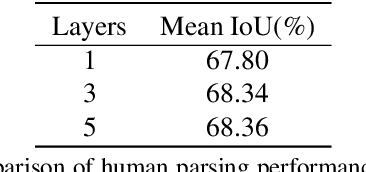
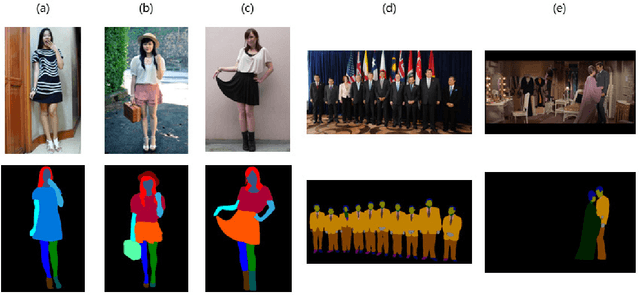


Abstract:Prior highly-tuned human parsing models tend to fit towards each dataset in a specific domain or with discrepant label granularity, and can hardly be adapted to other human parsing tasks without extensive re-training. In this paper, we aim to learn a single universal human parsing model that can tackle all kinds of human parsing needs by unifying label annotations from different domains or at various levels of granularity. This poses many fundamental learning challenges, e.g. discovering underlying semantic structures among different label granularity, performing proper transfer learning across different image domains, and identifying and utilizing label redundancies across related tasks. To address these challenges, we propose a new universal human parsing agent, named "Graphonomy", which incorporates hierarchical graph transfer learning upon the conventional parsing network to encode the underlying label semantic structures and propagate relevant semantic information. In particular, Graphonomy first learns and propagates compact high-level graph representation among the labels within one dataset via Intra-Graph Reasoning, and then transfers semantic information across multiple datasets via Inter-Graph Transfer. Various graph transfer dependencies (\eg, similarity, linguistic knowledge) between different datasets are analyzed and encoded to enhance graph transfer capability. By distilling universal semantic graph representation to each specific task, Graphonomy is able to predict all levels of parsing labels in one system without piling up the complexity. Experimental results show Graphonomy effectively achieves the state-of-the-art results on three human parsing benchmarks as well as advantageous universal human parsing performance.
Weakly Supervised Person Re-identification: Cost-effective Learning with A New Benchmark
Apr 08, 2019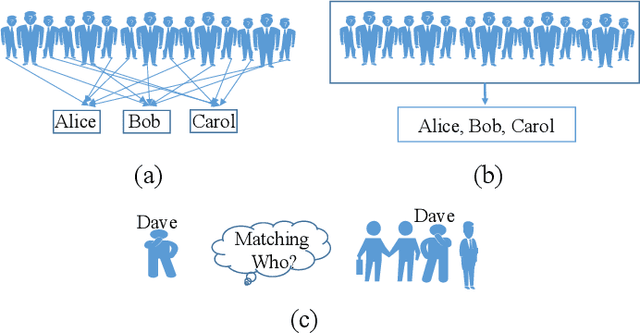
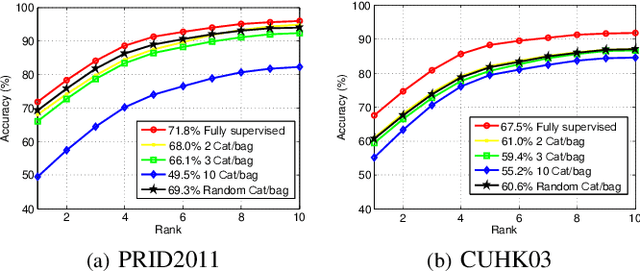


Abstract:Person re-identification (ReID) benefits greatly from the accurate annotations of existing datasets (e.g., CUHK03 \cite{li2014deepreid} and Market-1501 \cite{zheng2015scalable}), which are quite expensive because each image in these datasets has to be assigned with a proper label. In this work, we explore to ease the annotation of ReID by replacing the accurate annotation with inaccurate annotation, i.e., we group the images into bags in terms of time and assign a bag-level label for each bag. This greatly reduces the annotation effort and leads to the creation of a large-scale ReID benchmark called SYSU-30$k$. The new benchmark contains $30k$ categories of persons, which is about $20$ times larger than CUHK03 ($1.3k$ categories) and Market-1501 ($1.5k$ categories), and $30$ times larger the ImageNet ($1k$ categories). It totally sums up to 29,606,918 images. Learning a ReID model with bag-level annotation is called the weakly supervised ReID problem. To solve this problem, we introduce conditional random fields (CRFs) to capture the dependencies from all images in a bag and generate a reliable pseudo label for each person image. The pseudo label is further used to supervise the learning of the ReID model. When compared with the fully supervised ReID models, our method achieves the state-of-the-art performance on SYSU-30$k$ and other datasets. The code, dataset, and pretrained model will be available online.
Adaptively Connected Neural Networks
Apr 07, 2019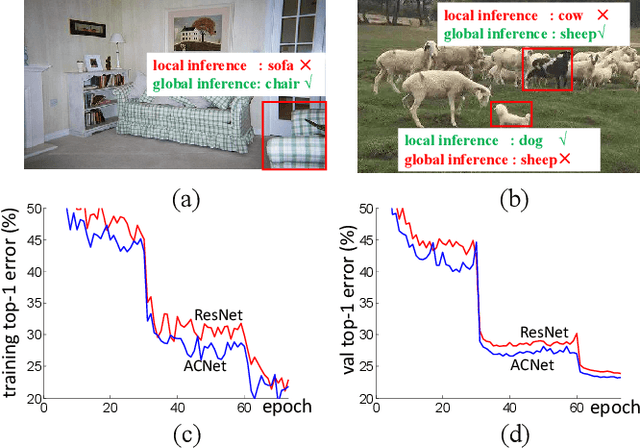

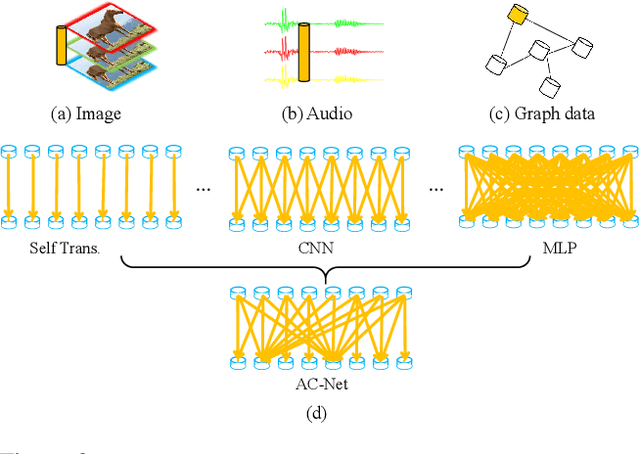

Abstract:This paper presents a novel adaptively connected neural network (ACNet) to improve the traditional convolutional neural networks (CNNs) {in} two aspects. First, ACNet employs a flexible way to switch global and local inference in processing the internal feature representations by adaptively determining the connection status among the feature nodes (e.g., pixels of the feature maps) \footnote{In a computer vision domain, a node refers to a pixel of a feature map{, while} in {the} graph domain, a node denotes a graph node.}. We can show that existing CNNs, the classical multilayer perceptron (MLP), and the recently proposed non-local network (NLN) \cite{nonlocalnn17} are all special cases of ACNet. Second, ACNet is also capable of handling non-Euclidean data. Extensive experimental analyses on {a variety of benchmarks (i.e.,} ImageNet-1k classification, COCO 2017 detection and segmentation, CUHK03 person re-identification, CIFAR analysis, and Cora document categorization) demonstrate that {ACNet} cannot only achieve state-of-the-art performance but also overcome the limitation of the conventional MLP and CNN \footnote{Corresponding author: Liang Lin (linliang@ieee.org)}. The code is available at \url{https://github.com/wanggrun/Adaptively-Connected-Neural-Networks}.
Weakly-Supervised Discovery of Geometry-Aware Representation for 3D Human Pose Estimation
Mar 27, 2019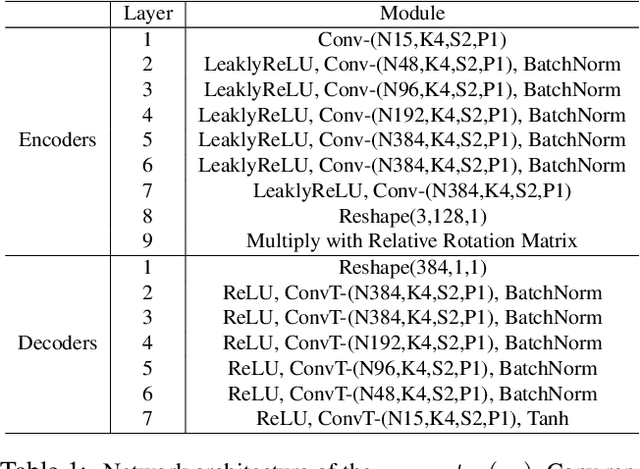
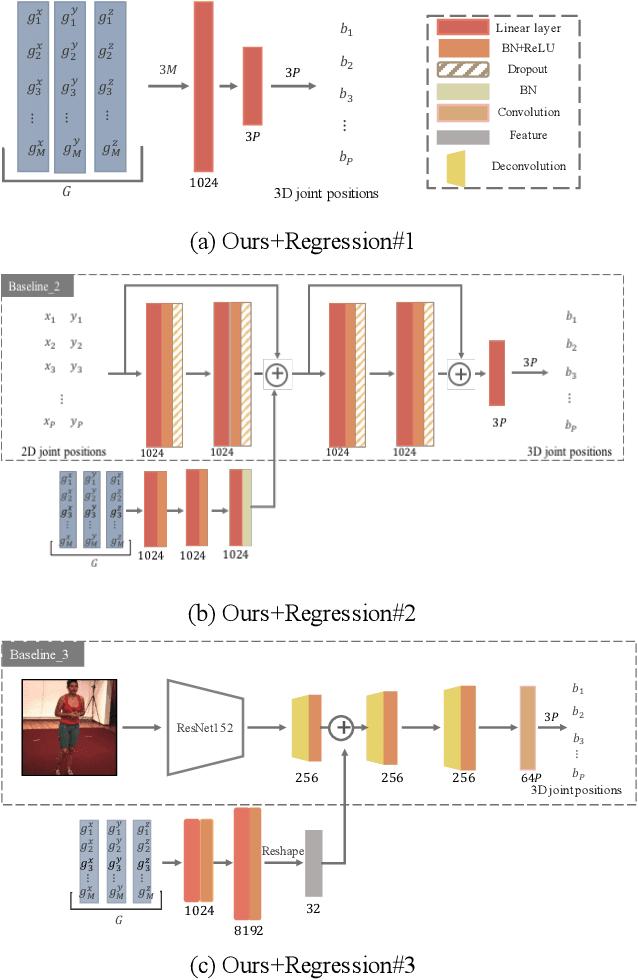
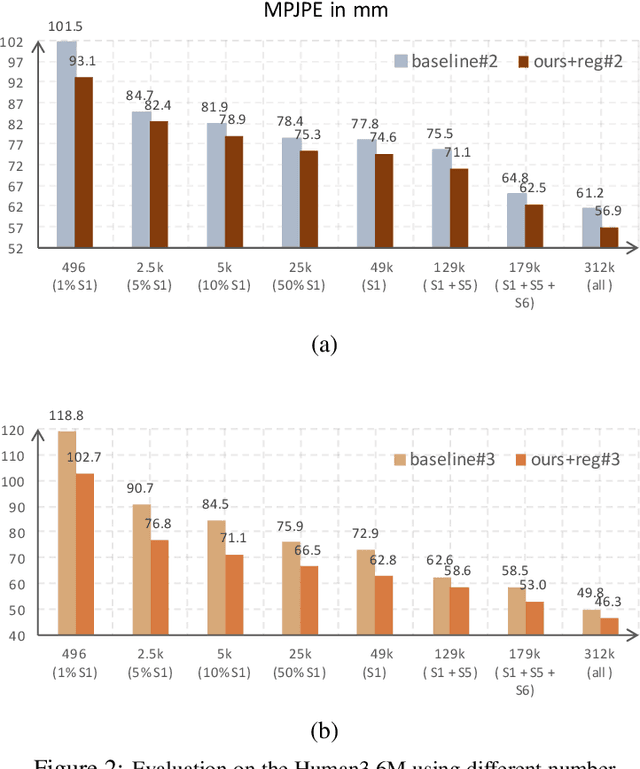
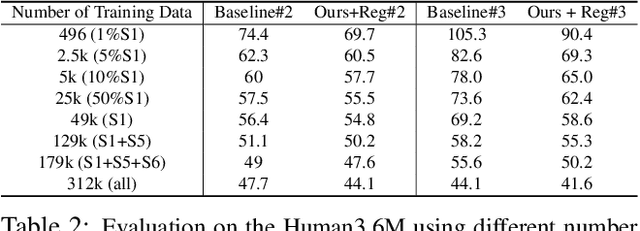
Abstract:Recent studies have shown remarkable advances in 3D human pose estimation from monocular images, with the help of large-scale in-door 3D datasets and sophisticated network architectures. However, the generalizability to different environments remains an elusive goal. In this work, we propose a geometry-aware 3D representation for the human pose to address this limitation by using multiple views in a simple auto-encoder model at the training stage and only 2D keypoint information as supervision. A view synthesis framework is proposed to learn the shared 3D representation between viewpoints with synthesizing the human pose from one viewpoint to the other one. Instead of performing a direct transfer in the raw image-level, we propose a skeleton-based encoder-decoder mechanism to distil only pose-related representation in the latent space. A learning-based representation consistency constraint is further introduced to facilitate the robustness of latent 3D representation. Since the learnt representation encodes 3D geometry information, mapping it to 3D pose will be much easier than conventional frameworks that use an image or 2D coordinates as the input of 3D pose estimator. We demonstrate our approach on the task of 3D human pose estimation. Comprehensive experiments on three popular benchmarks show that our model can significantly improve the performance of state-of-the-art methods with simply injecting the representation as a robust 3D prior.
End-to-End Knowledge-Routed Relational Dialogue System for Automatic Diagnosis
Mar 18, 2019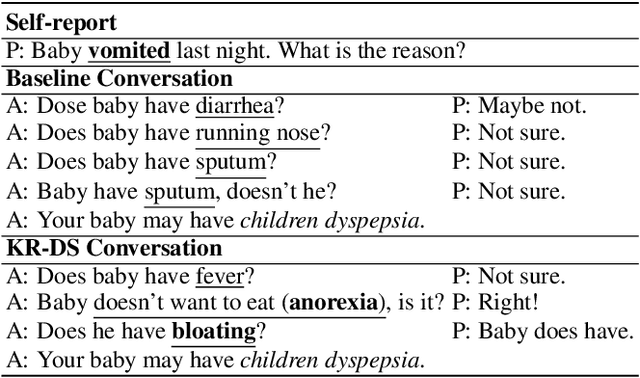
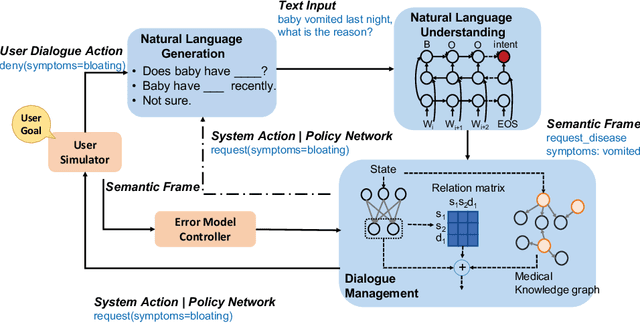
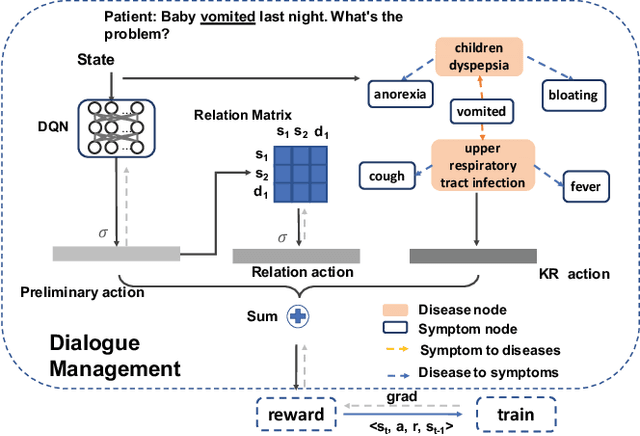

Abstract:Beyond current conversational chatbots or task-oriented dialogue systems that have attracted increasing attention, we move forward to develop a dialogue system for automatic medical diagnosis that converses with patients to collect additional symptoms beyond their self-reports and automatically makes a diagnosis. Besides the challenges for conversational dialogue systems (e.g. topic transition coherency and question understanding), automatic medical diagnosis further poses more critical requirements for the dialogue rationality in the context of medical knowledge and symptom-disease relations. Existing dialogue systems (Madotto, Wu, and Fung 2018; Wei et al. 2018; Li et al. 2017) mostly rely on data-driven learning and cannot be able to encode extra expert knowledge graph. In this work, we propose an End-to-End Knowledge-routed Relational Dialogue System (KR-DS) that seamlessly incorporates rich medical knowledge graph into the topic transition in dialogue management, and makes it cooperative with natural language understanding and natural language generation. A novel Knowledge-routed Deep Q-network (KR-DQN) is introduced to manage topic transitions, which integrates a relational refinement branch for encoding relations among different symptoms and symptom-disease pairs, and a knowledge-routed graph branch for topic decision-making. Extensive experiments on a public medical dialogue dataset show our KR-DS significantly beats state-of-the-art methods (by more than 8% in diagnosis accuracy). We further show the superiority of our KR-DS on a newly collected medical dialogue system dataset, which is more challenging retaining original self-reports and conversational data between patients and doctors.
Knowledge-Embedded Routing Network for Scene Graph Generation
Mar 08, 2019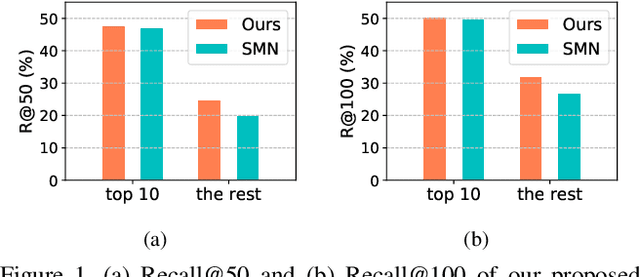

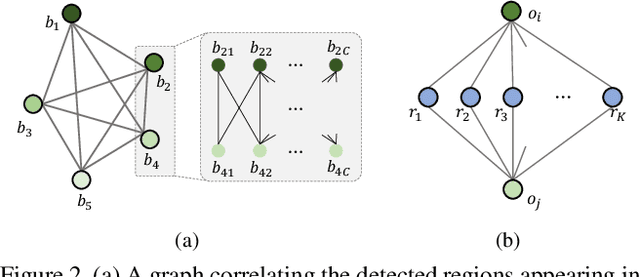
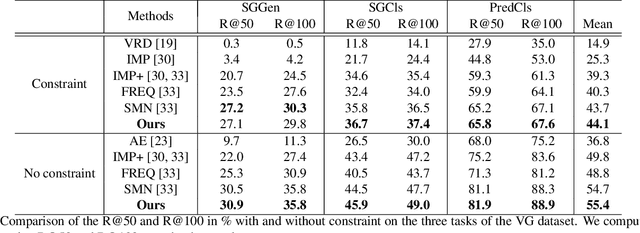
Abstract:To understand a scene in depth not only involves locating/recognizing individual objects, but also requires to infer the relationships and interactions among them. However, since the distribution of real-world relationships is seriously unbalanced, existing methods perform quite poorly for the less frequent relationships. In this work, we find that the statistical correlations between object pairs and their relationships can effectively regularize semantic space and make prediction less ambiguous, and thus well address the unbalanced distribution issue. To achieve this, we incorporate these statistical correlations into deep neural networks to facilitate scene graph generation by developing a Knowledge-Embedded Routing Network. More specifically, we show that the statistical correlations between objects appearing in images and their relationships, can be explicitly represented by a structured knowledge graph, and a routing mechanism is learned to propagate messages through the graph to explore their interactions. Extensive experiments on the large-scale Visual Genome dataset demonstrate the superiority of the proposed method over current state-of-the-art competitors.
FRAME Revisited: An Interpretation View Based on Particle Evolution
Jan 16, 2019
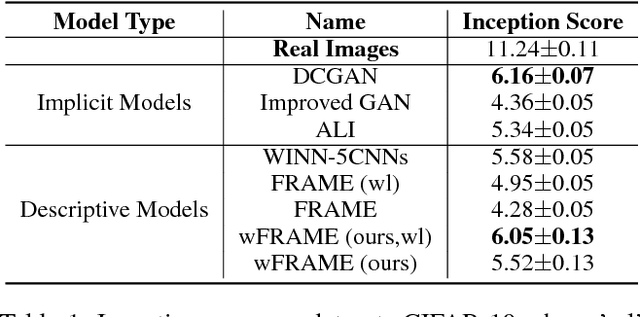
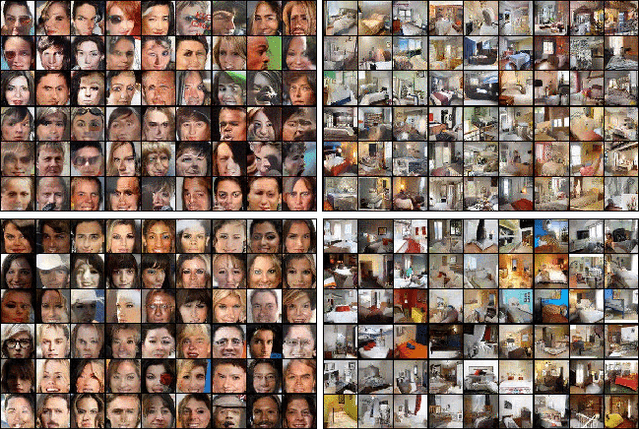
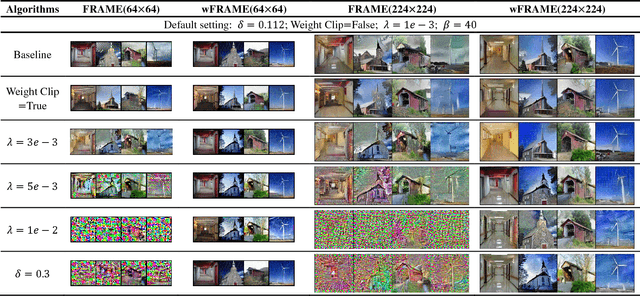
Abstract:FRAME (Filters, Random fields, And Maximum Entropy) is an energy-based descriptive model that synthesizes visual realism by capturing mutual patterns from structural input signals. The maximum likelihood estimation (MLE) is applied by default, yet conventionally causes the unstable training energy that wrecks the generated structures, which remains unexplained. In this paper, we provide a new theoretical insight to analyze FRAME, from a perspective of particle physics ascribing the weird phenomenon to KL-vanishing issue. In order to stabilize the energy dissipation, we propose an alternative Wasserstein distance in discrete time based on the conclusion that the Jordan-Kinderlehrer-Otto (JKO) discrete flow approximates KL discrete flow when the time step size tends to 0. Besides, this metric can still maintain the model's statistical consistency. Quantitative and qualitative experiments have been respectively conducted on several widely used datasets. The empirical studies have evidenced the effectiveness and superiority of our method.
3D Human Pose Machines with Self-supervised Learning
Jan 15, 2019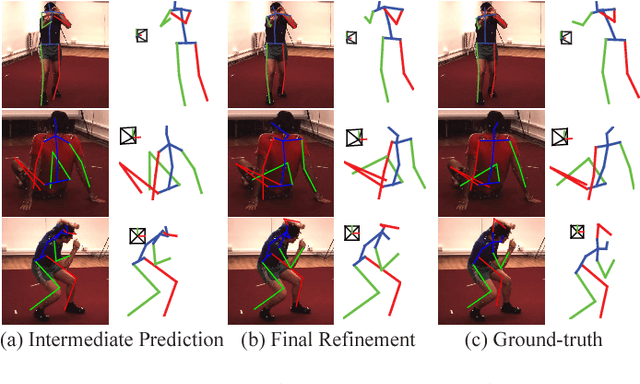

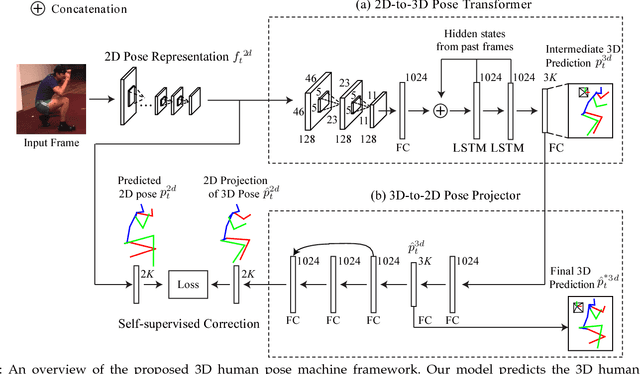
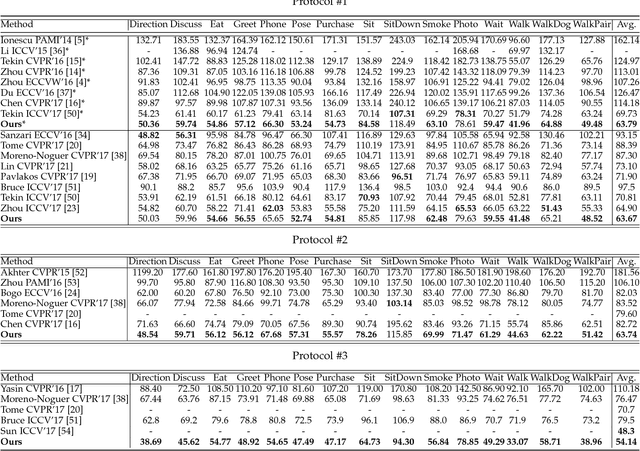
Abstract:Driven by recent computer vision and robotic applications, recovering 3D human poses has become increasingly important and attracted growing interests. In fact, completing this task is quite challenging due to the diverse appearances, viewpoints, occlusions and inherently geometric ambiguities inside monocular images. Most of the existing methods focus on designing some elaborate priors /constraints to directly regress 3D human poses based on the corresponding 2D human pose-aware features or 2D pose predictions. However, due to the insufficient 3D pose data for training and the domain gap between 2D space and 3D space, these methods have limited scalabilities for all practical scenarios (e.g., outdoor scene). Attempt to address this issue, this paper proposes a simple yet effective self-supervised correction mechanism to learn all intrinsic structures of human poses from abundant images. Specifically, the proposed mechanism involves two dual learning tasks, i.e., the 2D-to-3D pose transformation and 3D-to-2D pose projection, to serve as a bridge between 3D and 2D human poses in a type of "free" self-supervision for accurate 3D human pose estimation. The 2D-to-3D pose implies to sequentially regress intermediate 3D poses by transforming the pose representation from the 2D domain to the 3D domain under the sequence-dependent temporal context, while the 3D-to-2D pose projection contributes to refining the intermediate 3D poses by maintaining geometric consistency between the 2D projections of 3D poses and the estimated 2D poses. We further apply our self-supervised correction mechanism to develop a 3D human pose machine, which jointly integrates the 2D spatial relationship, temporal smoothness of predictions and 3D geometric knowledge. Extensive evaluations demonstrate the superior performance and efficiency of our framework over all the compared competing methods.
SNAS: Stochastic Neural Architecture Search
Jan 12, 2019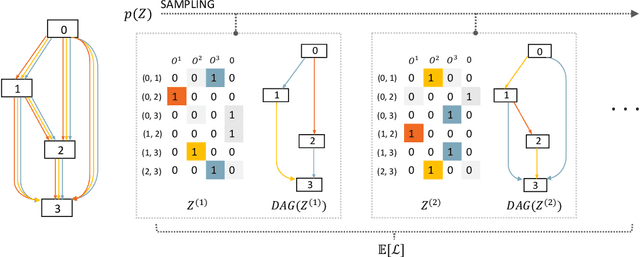

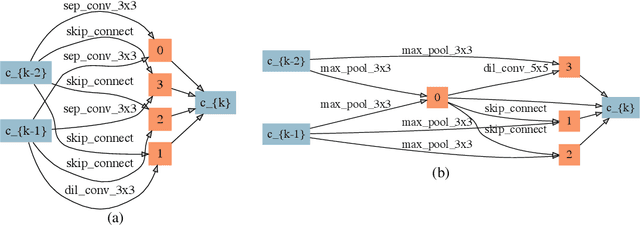
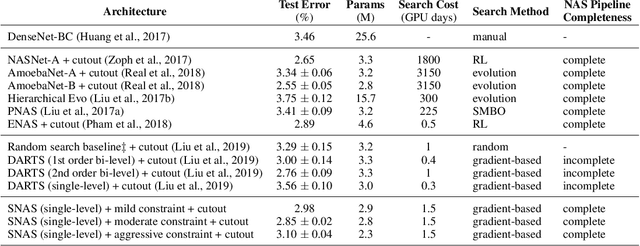
Abstract:We propose Stochastic Neural Architecture Search (SNAS), an economical end-to-end solution to Neural Architecture Search (NAS) that trains neural operation parameters and architecture distribution parameters in same round of back-propagation, while maintaining the completeness and differentiability of the NAS pipeline. In this work, NAS is reformulated as an optimization problem on parameters of a joint distribution for the search space in a cell. To leverage the gradient information in generic differentiable loss for architecture search, a novel search gradient is proposed. We prove that this search gradient optimizes the same objective as reinforcement-learning-based NAS, but assigns credits to structural decisions more efficiently. This credit assignment is further augmented with locally decomposable reward to enforce a resource-efficient constraint. In experiments on CIFAR-10, SNAS takes less epochs to find a cell architecture with state-of-the-art accuracy than non-differentiable evolution-based and reinforcement-learning-based NAS, which is also transferable to ImageNet. It is also shown that child networks of SNAS can maintain the validation accuracy in searching, with which attention-based NAS requires parameter retraining to compete, exhibiting potentials to stride towards efficient NAS on big datasets.
NADPEx: An on-policy temporally consistent exploration method for deep reinforcement learning
Dec 24, 2018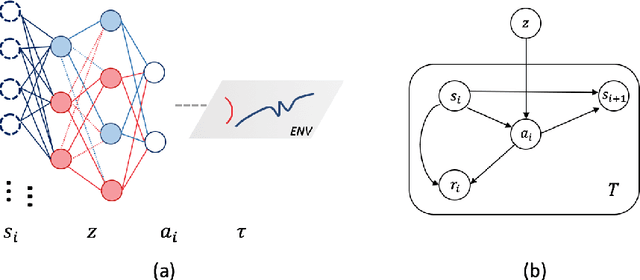
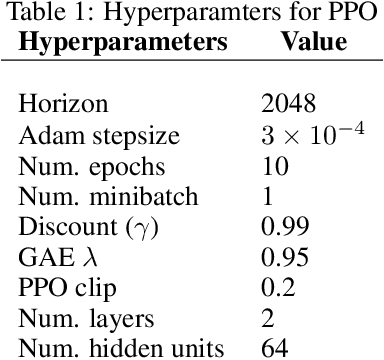


Abstract:Reinforcement learning agents need exploratory behaviors to escape from local optima. These behaviors may include both immediate dithering perturbation and temporally consistent exploration. To achieve these, a stochastic policy model that is inherently consistent through a period of time is in desire, especially for tasks with either sparse rewards or long term information. In this work, we introduce a novel on-policy temporally consistent exploration strategy - Neural Adaptive Dropout Policy Exploration (NADPEx) - for deep reinforcement learning agents. Modeled as a global random variable for conditional distribution, dropout is incorporated to reinforcement learning policies, equipping them with inherent temporal consistency, even when the reward signals are sparse. Two factors, gradients' alignment with the objective and KL constraint in policy space, are discussed to guarantee NADPEx policy's stable improvement. Our experiments demonstrate that NADPEx solves tasks with sparse reward while naive exploration and parameter noise fail. It yields as well or even faster convergence in the standard mujoco benchmark for continuous control.
 Add to Chrome
Add to Chrome Add to Firefox
Add to Firefox Add to Edge
Add to Edge